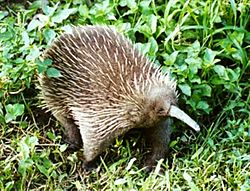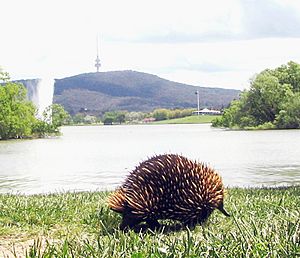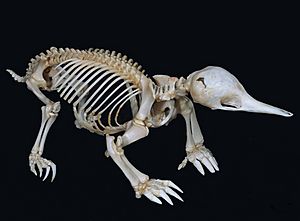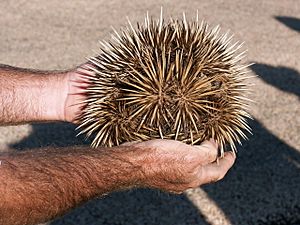What Animal Digs A Hole And Lays White Eggs
| Quick facts for kids Echidnas | |
|---|---|
 | |
| Western Long-beaked Echidna | |
| Scientific nomenclature | |
| Kingdom: | Animalia |
| Phylum: | Chordata |
| Class: | Mammalia |
| Order: | Monotremata |
| Family: | Tachyglossidae Gill, 1872 |
| Species | |
| Genus Tachyglossus | |

An Echnida looking for food
Echidna, the spiny anteater, is a monotreme that lives in Australia and in New Republic of guinea. They are the living members of the family Tachyglossidae.
Echnidas have a long, tube-like oral fissure with a sticky natural language, and they are also covered in spines. They have mammary glands, and lay eggs.
The echidna has a way of protecting itself. With its long, sharp claws, they quickly dig a hole until only their spines are showing. The predator volition not be able to get to information technology without injuring itself. When there is a burn down, the Echidna will dig down out of reach of the burn down.
Contents
- Description
- Nutrition
- Habitat
- Classification
- Reproduction
- Threats
- Evolution
- Taxonomy
- Zaglossus
- Tachyglossus
- Megalibgwilia
- As food
- In popular culture
Description
Echidnas are medium-sized, alone mammals covered with coarse hair and spines.

Spines and fur of an echidna
Superficially, they resemble the anteaters of South America and other spiny mammals such as hedgehogs and porcupines. They are ordinarily black or brown in colour. In that location take been several reports of albino echidnas, their eyes pink and their spines white. They accept elongated and slender snouts that function as both mouth and olfactory organ. Like the platypus, they are equipped with electrosensors, only while the platypus has 40,000 electroreceptors on its bill, the long-beaked echidna has only 2,000 electroreceptors, and the short-beaked echidna, which lives in a drier environment, has no more 400 located at the tip of its snout. They have very short, strong limbs with big claws, and are powerful diggers. Echidnas have tiny mouths and toothless jaws. The echidna feeds by trigger-happy open soft logs, anthills and the similar, and using its long, sticky natural language, which protrudes from its snout, to collect prey. The echidnas' ears are slits on the sides of their heads that are commonly unseen due to the fact that they are blanketed past their spines. The external ear is created by a large cartilaginous funnel, deep in the muscle.
Diet
The brusk-beaked echidna's diet consists largely of ants and termites, while the Zaglossus (long-beaked) species typically eat worms and insect larvae. The tongues of long-beaked echidnas have sharp, tiny spines that aid them capture their prey. They have no teeth, and break downwardly their food by grinding it between the bottoms of their mouths and their tongues. Echidnas' faeces are 7 centimetres long and are cylindrical in shape; they are commonly broken and unrounded, and equanimous largely of dirt and emmet-hill fabric.
Habitat
Echidnas practice non tolerate extreme temperatures; they apply caves and stone crevices to shelter from harsh weather condition conditions. Echidnas are found in forests and woodlands, hiding under vegetation, roots or piles of debris. They sometimes use the burrows of animals such every bit rabbits and wombats. Private echidnas have large, mutually overlapping territories.
Echidnas are capable swimmers. When pond, they expose their snout and some of their spines. They are known to journeying to water in order to groom and bathe themselves.
Classification
Echidnas and the platypus are the only egg-laying mammals, known equally monotremes. The boilerplate lifespan of an echidna in the wild is estimated around 16 years. When fully grown a female can weigh upwards to 4.5 kilograms (ix.9 lbs) and a male can counterbalance up to six kilograms (13.2 lbs). The echidnas' sexual practice can be inferred from their size, equally males are 25% larger than females on boilerplate. The reproductive organs also differ, only both sexes have a single opening called a cloaca, which they utilize to urinate, release their faeces and to mate.
Male echidnas accept non-venomous spurs on the hind feet.
The neocortex makes up half of the echidna's brain, compared to 80% of a human brain. Due to their low metabolism and accompanying stress resistance, echidnas are long-lived for their size; the longest recorded lifespan for a captive echidna is 50 years, with anecdotal accounts of wild individuals reaching 45 years. Contrary to previous enquiry, the echidna does enter REM sleep, but simply when the ambient temperature is around 25 °C (77 °F). At temperatures of xv °C (59 °F) and 28 °C (82 °F), REM sleep is suppressed.
Reproduction
The female person lays a single soft-shelled, leathery egg 22 days after mating, and deposits it straight into her pouch. An egg weighs 380 milligrams (some sources say 1.5 – 2 grams) and is well-nigh 1.4 centimetres long. While hatching, the baby echidna opens the leather beat out with a reptile-like egg tooth. Hatching takes place after 10 days of gestation; the immature echidna, called a puggle, built-in larval and fetus-like, then sucks milk from the pores of the two milk patches (monotremes have no nipples) and remains in the pouch for 45 to 55 days, at which fourth dimension information technology starts to develop spines. The mother digs a nursery burrow and deposits the immature, returning every five days to suckle it until it is weaned at seven months. Puggles will stay within their mother'south den for upwards to a yr earlier leaving.
Male person echidnas have a four-headed penis.
Breeding season begins in tardily June and extends through September. Males will form lines up to ten individuals long, the youngest echidna abaft terminal, that follow the female and attempt to mate. During a mating season an echidna may switch betwixt lines. This is known as the "train" system.
Threats
Echidnas are very timid animals. When they feel endangered they effort to bury themselves or if exposed they will curl into a ball, both methods using their spines to shield them. Potent front arms let echidnas to go on to dig themselves in whilst holding fast against a predator attempting to remove them from the hole. Although they have a way to protect themselves, the echidnas nonetheless face many dangers. Some predators include wild cats, foxes, domestic dogs and goannas. Snakes pose as a large threat to the echidna species because they slither into their burrows and prey on the immature spineless puggles. Some precautions that can be taken include keeping the environment clean by picking up litter and causing less pollution, planting vegetation for echidnas to utilise as shelter, supervising pets, reporting hurt echidnas or only leaving them undisturbed. Merely grabbing them may crusade stress, and picking them up improperly may even consequence in injury.
Evolution

Short-beaked echidna skeleton
The commencement divergence between oviparous (egg-laying) and viviparous (offspring develop internally) mammals is believed to have occurred during the Triassic period. However, there is however some disagreement on this estimated fourth dimension of divergence. Though nigh findings from genetics studies (especially those concerning nuclear genes) are in agreement with the paleontological findings, some results from other techniques and sources, similar mitochondrial Deoxyribonucleic acid, are in slight disagreement with findings from fossils.
Molecular clock data suggest echidnas split from platypuses between xix and 48 1000000 years agone, and that platypus-like fossils dating back to over 112.five million years ago therefore represent basal forms, rather than close relatives of the modern platypus. This would imply that echidnas evolved from h2o-foraging ancestors that returned to living completely on the land, fifty-fifty though this put them in competition with marsupials. Further evidence of possible h2o-foraging ancestors can be found in some of the echidna's phenotypic traits equally well. Traits such equally: as hydrodynamic streamlining, dorsally projecting hind limbs acting every bit rudders, and locomotion founded on hypertrophied humeral long-axis rotation, which provides a very efficient swimming stroke. Consequently, oviparous reproduction in monotremes may have given them an advantage over marsupials, a view consistent with present ecological division between the ii groups. This advantage could likewise be in part responsible for the observed associated adaptive radiation of echidnas and expansion of the niche space, which together contradict the adequately common assumption of halted morphological and molecular evolution that continues to exist associated with monotremes. Furthermore, studies of mitochondrial Dna in platypuses have also institute that monotremes and marsupials are most likely sis taxa. It likewise implies that any shared derived morphological traits betwixt marsupials and placental mammals either occurred independently from one another or were lost in the lineage to monotremes.
Taxonomy

In Australia, the short-beaked echidna may be found in many environments, including urban parkland, such as the shores of Lake Burley Griffin in Canberra, as depicted here.
Echidnas are classified into three genera. The genus Zaglossus includes three extant species and ii species known just from fossils, while merely one extant species from the genus Tachyglossus is known. The third genus, Megalibgwilia, is known only from fossils.
Zaglossus
The three living Zaglossus species are endemic to New Guinea. They are rare and are hunted for nutrient. They forage in foliage litter on the woods floor, eating earthworms and insects. The species are:
- Western long-beaked echidna (Z. bruijni), of the highland forests;
- Sir David's long-beaked echidna (Z. attenboroughi), described in 1961 and preferring a still higher habitat;
- Eastern long-beaked echidna (Z. bartoni), of which four distinct subspecies have been identified.
The 2 fossil species are:
- †Zaglossus robustus;
- †Zaglossus hacketti.
Tachyglossus
The brusque-beaked echidna (Tachyglossus aculeatus) is establish in southern, southeast and northeast New Guinea, and likewise occurs in nigh all Australian environments, from the snowfall-clad Australian Alps to the deep deserts of the Outback, substantially anywhere ants and termites are bachelor. It is smaller than the Zaglossus species, and it has longer hair.

Despite the like dietary habits and methods of consumption to those of an anteater, at that place is no testify supporting the idea that echidna-similar monotremes take been myrmecophagic (ant or termite-eating) since the Cretaceous. The fossil testify of invertebrate-feeding bandicoots and rat-kangaroos, from effectually the time of the platypus–echidna divergence and pre-dating Tachyglossus, show evidence that echidnas expanded into new ecospace despite competition from marsupials.
Megalibgwilia
The genus Megalibgwilia is known only from fossils:
- M. ramsayi from Belatedly Pleistocene sites in Australia;
- M. robusta from Miocene sites in Australia.
As food
Aboriginal Australians regard the echidna as a food delicacy.
In popular culture
- The echidna appears on the reverse of the Australian 5-cent coin.
- Duke the Echidna is a red echidna featured in the video game series Sonic the Hedgehog, in which he is depicted as being the final of his kind.
- Duke also appears in the Sonic the Hedgehog comic series in which other echidnas are also depicted; notable mentions include Julie-Su, Lien-Da, Kragok, Dimitri, & Lara-Su.
- Millie, an echidna, was a mascot for the 2000 Summertime Olympics.
- The Echidna from Guardians of Ga'hoole and its 2010 animated film accommodation.
- Some have argued that the Niffler—a creature from the Harry Potter universe which steals shiny objects—was based on the echidna.
- Pet echidnas, which are hatched from eggs, can be kept in National Geographic Animal Jam.
All content from Kiddle encyclopedia articles (including the article images and facts) can exist freely used under Attribution-ShareAlike license, unless stated otherwise. Cite this commodity:
Echidna Facts for Kids. Kiddle Encyclopedia.
Source: https://kids.kiddle.co/Echidna
Posted by: wisehumpertle.blogspot.com

0 Response to "What Animal Digs A Hole And Lays White Eggs"
Post a Comment